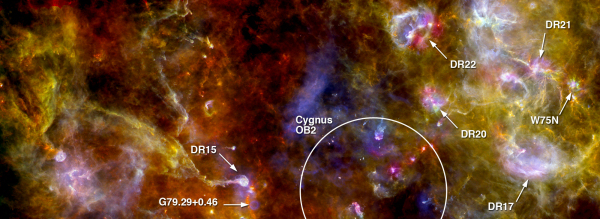How massive stars sculpt a cosmic crib
Between two of the brightest stars of the constellation Cygnus (the Swan) but hidden to human eyes and optical telescopes, lies an intricate network of glowing clouds where thousands of stars are being born. This region, known as the Cygnus X complex, is characterised by fierce, intense star formation activity resulting in an exceptionally abundant production of massive stars.
A new image of the Cygnus X complex, obtained with ESA's Herschel Space Observatory at far-infrared wavelengths, reveals the emission from gas, dust and forming stars in this region at unprecedented detail. The image combines data acquired with the PACS instrument at 70 micron (shown in blue) and 160 micron (shown in green) and with the SPIRE instrument at 250 micron (shown in red).
Located at a distance of about 4500 light years from us, Cygnus X is the richest stellar nursery in our cosmic neighbourhood and is home to a large number of young, massive stars. Although an even larger number of low-mass stars are forming throughout the region, it is the presence of so many massive stars, with their powerful winds and copious amounts of ionising radiation released into their surroundings, that forges most of the structure that can be seen across the image. Astronomers investigate the various regions in the Cygnus X complex to understand how feedback from massive stars is influencing the ongoing star formation across the entire region, and the images collected with Herschel are adding new clues to these studies.
 |
|
The Cygnus X star-forming complex (annotated). Credit: ESA/PACS/SPIRE/Martin Hennemann & Frédérique Motte, Laboratoire AIM Paris-Saclay, CEA/Irfu - CNRS/INSU - Univ. Paris Diderot, France |
An OB association, or a loose stellar group containing a large number of young, massive stars of types O and B, is hosted in the complex, in the central-lower part of the image, to the lower-right of the diffuse blue glow. This association, known as Cygnus OB2, hosts thousands of stars, and although they are not visible in the Herschel image their remarkable effects on the nearby clouds stand out clearly. An example is the diffuse blue glow visible in the central portion of the image: it is the result of powerful winds and radiation from stars in the OB association, which have partly cleared out and heated up the surrounding material, making it shine.
The intricate network of filaments and pillars in the right part of the image may be harbouring the formation of a new, rich OB association, thus showing how Cygnus OB2 might have looked in its infancy, about 3 million years ago. One of the most notable features in this portion of the image is the DR21 region, an extremely dense filamentary structure that bifurcates towards the right. Very massive stars are forming along this filament, and astronomers are studying them in great detail to shed new light on the processes that lead to the birth of high-mass stars.
Several bubble-like structures are also visible in the right part of the image: these are being carved by nearby massive young stars. The radiation released by these stars ionises the gas in their surroundings, causing the bubbles to shine brightly at the shortest of the wavelengths probed by Herschel (hence the blue-white glow that characterises these bubbles in the image).
In the left part of the image, the structure of clouds is more diffuse, with one prominent pillar-like feature, named DR15, whose shape resembles the neck of a swan. A highly symmetric bubble is visible, in blue, close to the edge of this pillar – likely a shell of material being ejected by the Luminous Blue Variable star G79.29+0.46, a supergiant star located at the centre of the shell but invisible at the wavelengths probed by Herschel.
Throughout the image, several clumps are visible as compact red objects: these are dense concentrations of matter that will evolve into the next generation of massive stars. Exploiting the extraordinary sensitivity of Herschel in this portion of the spectrum, astronomers have detected a large number of these seeds of future stars. This rich set of data is a valuable addition to the body of observational material that is contributing to advancing our current understanding of how massive stars come to shape and influence the formation of lower-mass stars in their surroundings.
| Fast Facts | |
| Depicted object: | Cygnus X |
| Additional details: | Star-forming region |
| Constellation: | Cygnus (the Swan) |
| Distance: | 4500 light years |
| Image Orientation: | North is to the lower-right, East to the upper-right |
| Image | |
| Satellite: | Herschel |
| Instruments: | PACS; SPIRE |
| Wavelengths: | 70 um (PACS; blue); 160 um (PACS; green); 250 um (SPIRE; red) |
| Field of view: | about 6 degrees on the horizontal side |
| Observation dates: | 24 May 2010 (Southern field; left part of the image) and 18 December 2010 (Northern field; right part of the image) |
| Release date: | 10 May 2012 |
| Credit: | ESA/PACS/SPIRE/Martin Hennemann & Frédérique Motte, Laboratoire AIM Paris-Saclay, CEA/Irfu - CNRS/INSU - Univ. Paris Diderot, France |
| Acknowledgments: | HOBYS Key Programme |
Contacts
Göran Pilbratt
Herschel Project Scientist
Research and Scientific Support Department
Science and Robotic Exploration Directorate
ESA, The Netherlands
Email: gpilbratt![]() rssd.esa.int
rssd.esa.int
Phone: +31-71-565-3621


